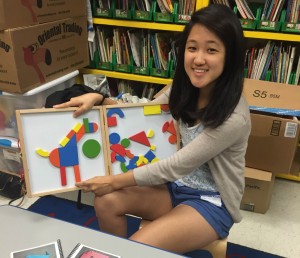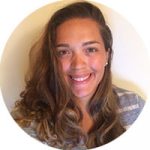
Elizabeth Cavic
Elizabeth Cavic is a rising senior in the Department of Human Development and was a 2017 College of Human Ecology CCE Summer Intern working on the project "Enhancing Children’s Play and Parent’s Knowledge in Suffolk County" under the direction of Dr. Marianella Casasola and the CCE partners, Suffolk County Family and Health and Wellness Program, and Suffolk County Farm and Education Center. She created the following e-journal of her internship experience.
Week 1!
This week was my first (almost) full week with the Cornell Cooperative Extension of Suffolk County (herein called "CCE"). I arrived on Memorial Day (Monday evening) around 10 PM and started work Tuesday. For the 6 weeks that I will be interning with CCE, I will be splitting my time between the Riverhead office and the Farm and Education Center (located in Yaphank). For the most part, I will be working in Riverhead Tuesdays and Wednesdays and in Yaphank on Mondays, Thursdays, and Fridays.
This first week was largely an orientation week for me. Several of my supervisors showed me 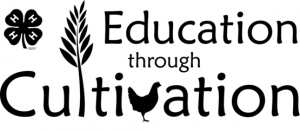 around the farm and Riverhead office, I was given my duties and workspaces, and I just generally oriented myself to my new surroundings! I enjoyed my time at the office a lot, as I'm surrounded by people who are experts in all their respective fields (all somehow relating to Family Health and Wellness). My time at the farm, however, was also super incredible. Growing up in upstate New York, I was always surrounded by long stretches of countryside and there was always a farm no more than 15 minutes or so in any direction. However, this did give me the opportunity to get up close and personal with some things I haven't seen in a long time (namely lambs and roosters), which I really enjoyed!
around the farm and Riverhead office, I was given my duties and workspaces, and I just generally oriented myself to my new surroundings! I enjoyed my time at the office a lot, as I'm surrounded by people who are experts in all their respective fields (all somehow relating to Family Health and Wellness). My time at the farm, however, was also super incredible. Growing up in upstate New York, I was always surrounded by long stretches of countryside and there was always a farm no more than 15 minutes or so in any direction. However, this did give me the opportunity to get up close and personal with some things I haven't seen in a long time (namely lambs and roosters), which I really enjoyed!
Of course, my job there is not to hang out with the adorable sheep and lambs, but to develop a design that helps parents understand how critical play is to development. For example, the Outdoor Explore classroom contains an element that is intended for children to paint on (with  water). Essentially, there are three pieces of slate (pictured left). Each piece of slate has a bucket attached, each bucket full of water and a couple paintbrushes. Water can be used to "paint" on these slates. While children may not look as though they are doing much during their painting sessions, the large sweeping motions that can be seen are critical to gross motor development in preschoolers.
water). Essentially, there are three pieces of slate (pictured left). Each piece of slate has a bucket attached, each bucket full of water and a couple paintbrushes. Water can be used to "paint" on these slates. While children may not look as though they are doing much during their painting sessions, the large sweeping motions that can be seen are critical to gross motor development in preschoolers.
Gross motor development (being able to control and manipulate the muscles in the shoulder and upper arm) is, then, absolutely imperative to the development of fine motor skills (manipulation of the hands and fingers). Of course, looking at a child fooling around with a bucket, and paintbrush, and a few pieces of slate may seem useless to parents who have little to no background in Human (specifically, Child) Development. That's where I come in. Of course, it's week 1, so I'm not quite sure yet how I come in, but I know that I definitely will! Until next week!
Week 2!
This week has flown by! Today marks the end of my first full week working for CCE of Suffolk County. This has been an extremely full week, complete with field trips, tours around preschools and other outdoor classrooms, a lot of statistics, graphs, charts, powerpoint presentations, and photos! Last week, largely an orientation week, was spent brainstorming ideas, as was much of this week.
The schedule for the duration of my internship is as follows: two weeks researching and brainstorming, two weeks implementing changes in the Outdoor Explore Classroom, and two 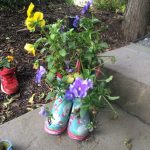 weeks tweaking my adjustments. One of the final steps in my first two weeks was to visit other outdoor classrooms in the area. Our first stop was at Play Groups School in East Setauket. This school was an absolute blast to visit - the classrooms were incredible, the instructors were all so professional and so warm (the perfect mix for preschool teachers), and all the children were playing with developmentally appropriate materials. This little flower-filled shoe (left) was used during their recycling/Earth day project, in which children planted flowers in their old shoes. Because of this, there were dozens of little flower-filled shoes sitting around the outdoor classroom which nearly brought me to tears.
weeks tweaking my adjustments. One of the final steps in my first two weeks was to visit other outdoor classrooms in the area. Our first stop was at Play Groups School in East Setauket. This school was an absolute blast to visit - the classrooms were incredible, the instructors were all so professional and so warm (the perfect mix for preschool teachers), and all the children were playing with developmentally appropriate materials. This little flower-filled shoe (left) was used during their recycling/Earth day project, in which children planted flowers in their old shoes. Because of this, there were dozens of little flower-filled shoes sitting around the outdoor classroom which nearly brought me to tears.
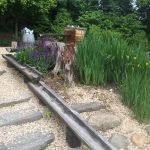 So much of the dialogue surrounding preschool education in the United States today is littered with talk of "didactic" learning or "academic- oriented preschools". However, the children of this preschool (and preschools across the country) were thriving with very simple (and age- appropriate) play materials! In fact, when walking in, I was a bit taken aback by the amount of material the children had at their disposal - water tables, dress up clothes, easels, fish tanks, huge playhouses inside the building, blocks, and countless other materials. It was, by all counts, incredible. The children were actively engaged in what they were doing and were learning new things with every move they made. Their outdoor classroom was equally impressive - between the water feature (right), the spot for bird-watching, the stage, the regular playground, and the block station, it was even difficult for me to stay professional.
So much of the dialogue surrounding preschool education in the United States today is littered with talk of "didactic" learning or "academic- oriented preschools". However, the children of this preschool (and preschools across the country) were thriving with very simple (and age- appropriate) play materials! In fact, when walking in, I was a bit taken aback by the amount of material the children had at their disposal - water tables, dress up clothes, easels, fish tanks, huge playhouses inside the building, blocks, and countless other materials. It was, by all counts, incredible. The children were actively engaged in what they were doing and were learning new things with every move they made. Their outdoor classroom was equally impressive - between the water feature (right), the spot for bird-watching, the stage, the regular playground, and the block station, it was even difficult for me to stay professional.
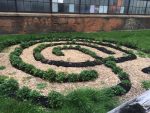 Next, we visited the Long Island Children's Museum (LICM). One of their most interesting features was the Strawberry Maze (left). The black material was a "composting sock," filled with compost material on which the strawberry plants were growing. Children went into the maze, completed it, and ate strawberries along the way. The museum also contained a beautiful water feature (with dams, rivers, a water wheel, etc.). This inspired me to continue working on the farm's future water feature.
Next, we visited the Long Island Children's Museum (LICM). One of their most interesting features was the Strawberry Maze (left). The black material was a "composting sock," filled with compost material on which the strawberry plants were growing. Children went into the maze, completed it, and ate strawberries along the way. The museum also contained a beautiful water feature (with dams, rivers, a water wheel, etc.). This inspired me to continue working on the farm's future water feature.
Next, we headed to the Middle Country Library. This library was so impressive for a whole multitude of reasons (some, but definitely not all of which, had to do with its outdoor explore classroom). This place was incredible:
- The men's bathroom had a changing table, which shouldn't be such a big deal but, even in 2017, is not a super common occurrence and any public organization where that occurs is, in my opinion, way ahead of the game!
- The outside of the building is - beyond being incredibly aesthetically pleasing - covered with what look like "fish scales". Very fitting for a library out in Long Island.
- They had a "I read 1000 books before Kindergarten" feature - there were 100 clear backpacks on the shelves, each of which contained 10 picture -- or very short chapter -- books. A child could take out a backpack, bring it home, read the 10 books, return the backpack, and there would be 99 more waiting for the child. When the child completed all 100 of the backpacks (and consequently 1000 books), he/she/they got their face on a wall of the other children who had completed it. No lie, this bulletin board made me tear up it was so adorable.
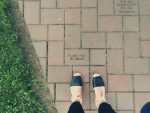 - back to the classroom - it was absolutely incredible. It had places for building, places for reading, performing, digging, etc. (and SO SO many caterpillars)... The photo above (of the brick and my then-soaking-wet-from-walking-through-the-damp-grass-all- day espadrilles) was part of a fundraiser that the library did to fund the outdoor classroom. Each brick contained a title of a children's book (the book referenced in this brick can be found here) and a sponsor could "buy" a brick for $100 prior to the building of the classroom. I found it to be so heartwarming looking through the books that people held close to their hearts.
- back to the classroom - it was absolutely incredible. It had places for building, places for reading, performing, digging, etc. (and SO SO many caterpillars)... The photo above (of the brick and my then-soaking-wet-from-walking-through-the-damp-grass-all- day espadrilles) was part of a fundraiser that the library did to fund the outdoor classroom. Each brick contained a title of a children's book (the book referenced in this brick can be found here) and a sponsor could "buy" a brick for $100 prior to the building of the classroom. I found it to be so heartwarming looking through the books that people held close to their hearts.
With all this work, I have (obviously) been very busy! However, there is always time to head down to the beach to put my feet in the water (it's still too chilly down here for a good swim - today is the best day thus far and it's only 75). As usual, I'm enjoying myself at work and in my spare time. I'm trying to read a book a week this summer and this week, the book that I have chosen is called "The Color of Water" by James McBride. So far so good. And for those of you who care or are curious, last week was "The Tipping Point" by Malcolm Gladwell. Equally wonderful and a super interesting non-fiction read. I'll make sure to keep you all updated on my progress (both personally and professionally) for the remainder of my internship. Until next week!
Week 3!
This week was so busy, I almost forgot to publish my post for this week (sorry about that, folks). This week started out on Monday with me finishing up preparations for my project - including making a supply list and merging that with my budget, researching how to implement a QR code for an audio tour the farm will be adding to the Nature Explore Classroom, and finalizing my list of projects that I'm going to work on!
After several long weeks of preparation, I finally started doing a project! This began on Sunday when my friend Marissa and I went to Southold Town beach and collected 360+ nicely-sized rocks!
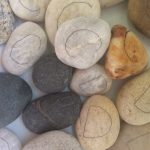 Surprisingly, that only took us 20-30 minutes (and I got to watch a super beautiful sunset on the water right afterwards, so I definitely was not complaining about having to be at the beach). On Monday, I brought my rocks to the farm and washed them off and then pre-sketched all the letters onto the rocks so they could be painted the following day that I was at the farm.
Surprisingly, that only took us 20-30 minutes (and I got to watch a super beautiful sunset on the water right afterwards, so I definitely was not complaining about having to be at the beach). On Monday, I brought my rocks to the farm and washed them off and then pre-sketched all the letters onto the rocks so they could be painted the following day that I was at the farm.
On Thursday morning, I scoured the farm for acrylic paints that we may have already had and began painting some of the rocks with that (below). Unfortunately, we only had 3 good colors (and of course, I'm a color addict, so I really wanted more than that for this project). Fortunately, one of my field supervisors (Katie) was super understanding about the fact that I needed more paint and we took a trip to Michaels to get supplies for the rocks (paints, paintbrushes, sealer, etc.) and a few of my other upcoming projects.
After returning to the farm, I finally got to start painting the bulk of them!
Now, I never really knew how to conceptualize 360 rocks before today, but now I know that that means literally an eight-hour day of just painting rocks.
I've added this photo (right) so that you all can begin to conceptualize how many rocks 360 really is! A ton! Regardless, I got it done and was really pleased with the final results. Next week, 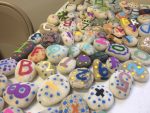 I will be sealing them so that they can be outside safely and will not chip or blister, etc. From here, I think that my next project will be the ribbon chandeliers. I don't foresee those taking too long, but I'm hoping that sometime soon I can get started on the mud kitchen!
I will be sealing them so that they can be outside safely and will not chip or blister, etc. From here, I think that my next project will be the ribbon chandeliers. I don't foresee those taking too long, but I'm hoping that sometime soon I can get started on the mud kitchen!
International Mud Day is coming faster than I had expected (it's this coming Saturday at 10 AM at the farm!) and I am not as prepared as I'd like to be, but still truckin' along! I think the implementation of that project will be a real game-changer for the Nature Explore Classroom (or at least I hope it will - I know I would've loved a mud kitchen as a kid). But anyway, I hope you all are having as great a summer as I am! Until next week.
Week 4!
I cannot believe that it's already my fourth week! As I write this (on Sunday actually - past my deadline), I am in shock that I only have 9 days left of my internship! This coming week, I will work Monday - Friday, and then the following week will be a four-day week, with July 4th on Tuesday.
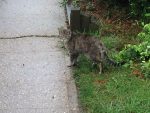 Anyway, this week was absolutely crazy! I (of course) got my weekly dose of run-ins with the farm cats (my favorite of which is pictured to the left), I got time at the Riverhead office, and yesterday (Saturday) was our celebration for international mud day! International mud day is actually June 29th, but for the sake of having a good turn out, we celebrated it the weekend before. For those who don't know know, mud day is literally just a day in which kids and adults come to the farm and play in mud (the entire time).
Anyway, this week was absolutely crazy! I (of course) got my weekly dose of run-ins with the farm cats (my favorite of which is pictured to the left), I got time at the Riverhead office, and yesterday (Saturday) was our celebration for international mud day! International mud day is actually June 29th, but for the sake of having a good turn out, we celebrated it the weekend before. For those who don't know know, mud day is literally just a day in which kids and adults come to the farm and play in mud (the entire time).
At the farm, that means two huge kiddie pools filled with topsoil are plopped on the ground, and water is added in the morning. Progressively, throughout the day,  children play in the pools, carry the mud around, sit in it, step on it, throw it at each other (and their parents), scoop it up with kitchen utensils and shovels, put it in baking pans, etc. The aftermath is what you see (right). When the pools are picked up, there is a 4-inch layer of mud left on the ground everywhere except where the pools were stationed. As you can imagine, the clean up for this event took a substantial amount of time, even with several people helping to get everything de-muddied. In fact, I think there is mud so deeply embedded in my feet right now that I'm at least 3 sheets browner from ankle down (even after several hose- offs and a shower).
children play in the pools, carry the mud around, sit in it, step on it, throw it at each other (and their parents), scoop it up with kitchen utensils and shovels, put it in baking pans, etc. The aftermath is what you see (right). When the pools are picked up, there is a 4-inch layer of mud left on the ground everywhere except where the pools were stationed. As you can imagine, the clean up for this event took a substantial amount of time, even with several people helping to get everything de-muddied. In fact, I think there is mud so deeply embedded in my feet right now that I'm at least 3 sheets browner from ankle down (even after several hose- offs and a shower).
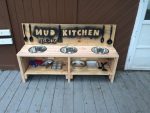 So, now to backtrack. This week I spent a lot of time prepping for International Mud Day. The biggest project that I worked on was making the mud kitchen (left)! This took several sketches and re-sketches, several trips to different stores, and a lot of help from Richard, the man who does maintenance work for the farm. It took a total of 7 hours, and by the end I couldn't feel my forearm (I used nails, not screws, ugh). However, I got my supplies on Thursday afternoon and it was finished by Friday and usable for Mud Day (which was the goal of this internship).
So, now to backtrack. This week I spent a lot of time prepping for International Mud Day. The biggest project that I worked on was making the mud kitchen (left)! This took several sketches and re-sketches, several trips to different stores, and a lot of help from Richard, the man who does maintenance work for the farm. It took a total of 7 hours, and by the end I couldn't feel my forearm (I used nails, not screws, ugh). However, I got my supplies on Thursday afternoon and it was finished by Friday and usable for Mud Day (which was the goal of this internship).
In total, the farm had about 2,000 people present for some portion of the festivities, a large 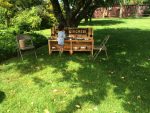 number of those people being under the age of 5! I was super pleased to see people enjoying the mud kitchen during the day, especially little people (one of these little people pictured left). The concept was stemmed from my boss Allison and I (with a little help from pinterest) and the execution was mostly me (although my dad's insistence that I learn how to use power tools in middle and high school did come in handy).
number of those people being under the age of 5! I was super pleased to see people enjoying the mud kitchen during the day, especially little people (one of these little people pictured left). The concept was stemmed from my boss Allison and I (with a little help from pinterest) and the execution was mostly me (although my dad's insistence that I learn how to use power tools in middle and high school did come in handy).
Fortunately, my mud kitchen was a disaster by the end of Mud Day! Anything less would have meant that I did my job poorly. Luckily, however, it is really easy to clean again (just take the bowls out and hose it off) and it's back to usable condition! Overall, I would definitely recommend this project to any adult who has children or who works with children - little ones are so infrequently allowed to get dirty anymore and it is a critical part of childhood!
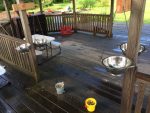 I was also lucky enough to have several of my other classroom additions ready in time for International Mud Day! Both my painted rocks and my scales were debuted that day (and from what I saw, kids were really enjoying them). Pictures of those can also be found below! I think there are a few things that I'd like to add or change, but overall I'm extremely pleased with the progress that I've made thus far. With a little under two weeks left, I'm signing off!
I was also lucky enough to have several of my other classroom additions ready in time for International Mud Day! Both my painted rocks and my scales were debuted that day (and from what I saw, kids were really enjoying them). Pictures of those can also be found below! I think there are a few things that I'd like to add or change, but overall I'm extremely pleased with the progress that I've made thus far. With a little under two weeks left, I'm signing off!
Week 5!
This week was, as usual, pretty hectic! I finished up several projects, including the water tables and my ribbon chandelier!
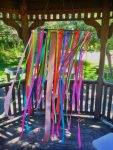 As you can see, my ribbon chandelier came out pretty cool! I was going for technicolor and really appealing to the eye (especially the young child's eye) and I think that's exactly how it came out! While I was securing it onto the gazebo, there was there this girl Marissa (who looked to be about two years old) with her parents and she kept coming up to me repeatedly saying, "there's a birthday party today!" because the ribbon chandelier looks like birthday streamers. Of course, her parents were rushing her along because her one-year-old brother was fussing, but what an incredible observation, connection, and conclusion on her part!
As you can see, my ribbon chandelier came out pretty cool! I was going for technicolor and really appealing to the eye (especially the young child's eye) and I think that's exactly how it came out! While I was securing it onto the gazebo, there was there this girl Marissa (who looked to be about two years old) with her parents and she kept coming up to me repeatedly saying, "there's a birthday party today!" because the ribbon chandelier looks like birthday streamers. Of course, her parents were rushing her along because her one-year-old brother was fussing, but what an incredible observation, connection, and conclusion on her part!
Finally, after it was hung up she got to go inside the hoop! As an added bonus, this was intended to a pretend play prop, which I believe it was for her. The entire time I was hanging this up, her hands were full of the letter rocks I painted, and she was putting them in the cupcake tins from Mud Day, calling them eggs she was using for "brownies" for the birthday that was happening! Very cool and imaginative little girl, indeed.
 We were also fortunate enough to receive a donation from someone the other day of a whole set of painted wooden "blocks." They were really just a a 2" x 2" piece of wood cut into smaller pieces, but that's all blocks ever are anyway, and plus, they were a donation, so they were better than nothing and the person was generous to have brought them all the way over here when they could have thrown them out! Anyway! I upcycled them with some of the leftover acrylic paint from the letter rocks and now we have a really cool set of blocks that I'll be putting outside later today!
We were also fortunate enough to receive a donation from someone the other day of a whole set of painted wooden "blocks." They were really just a a 2" x 2" piece of wood cut into smaller pieces, but that's all blocks ever are anyway, and plus, they were a donation, so they were better than nothing and the person was generous to have brought them all the way over here when they could have thrown them out! Anyway! I upcycled them with some of the leftover acrylic paint from the letter rocks and now we have a really cool set of blocks that I'll be putting outside later today!
And finally I was able to somewhat finish my water tables! I still need 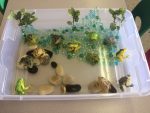 some of the PVC pipe connectors for the actual base, but my frogs came in, so the inside of them is done, which is very cool! I added some beach rocks as well, making it a little more realistic looking (and the kids can take the beach rocks out, so that's an additional thing to get some tactile experience with). Overall, I would say that my projects are going well and I am looking forward to wrapping everything up next week though I truly cannot believe that 6 weeks went by so quickly. It really does feel like yesterday that I was proctoring the Human Bonding Exam in Barton Hall! Anyway, thanks all for reading. Until next week!
some of the PVC pipe connectors for the actual base, but my frogs came in, so the inside of them is done, which is very cool! I added some beach rocks as well, making it a little more realistic looking (and the kids can take the beach rocks out, so that's an additional thing to get some tactile experience with). Overall, I would say that my projects are going well and I am looking forward to wrapping everything up next week though I truly cannot believe that 6 weeks went by so quickly. It really does feel like yesterday that I was proctoring the Human Bonding Exam in Barton Hall! Anyway, thanks all for reading. Until next week!











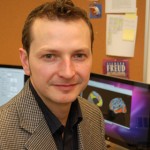 In a new paper,
In a new paper,  Lindsay Dower ‘17 spent her four years at Cornell working to improve the lives of both those within the College of Human Ecology and in the broader Ithaca community, truly embodying the mission of the college.
Lindsay Dower ‘17 spent her four years at Cornell working to improve the lives of both those within the College of Human Ecology and in the broader Ithaca community, truly embodying the mission of the college. Valerie Reyna - member of the National Academy of Medicine
Valerie Reyna - member of the National Academy of Medicine

 In a new study led by
In a new study led by  arianella Casasola
arianella Casasola New research by
New research by  Students in
Students in Daniel Rosenfeld '18 and his adviser
Daniel Rosenfeld '18 and his adviser 

 around the farm and Riverhead office, I was given my duties and workspaces, and I just generally oriented myself to my new surroundings! I enjoyed my time at the office a lot, as I'm surrounded by people who are experts in all their respective fields (all somehow relating to Family Health and Wellness). My time at the farm, however, was also super incredible. Growing up in upstate New York, I was always surrounded by long stretches of countryside and there was always a farm no more than 15 minutes or so in any direction. However, this did give me the opportunity to get up close and personal with some things I haven't seen in a long time (namely lambs and roosters), which I really enjoyed!
around the farm and Riverhead office, I was given my duties and workspaces, and I just generally oriented myself to my new surroundings! I enjoyed my time at the office a lot, as I'm surrounded by people who are experts in all their respective fields (all somehow relating to Family Health and Wellness). My time at the farm, however, was also super incredible. Growing up in upstate New York, I was always surrounded by long stretches of countryside and there was always a farm no more than 15 minutes or so in any direction. However, this did give me the opportunity to get up close and personal with some things I haven't seen in a long time (namely lambs and roosters), which I really enjoyed! water). Essentially, there are three pieces of slate (pictured left). Each piece of slate has a bucket attached, each bucket full of water and a couple paintbrushes. Water can be used to "paint" on these slates. While children may not look as though they are doing much during their painting sessions, the large sweeping motions that can be seen are critical to gross motor development in preschoolers.
water). Essentially, there are three pieces of slate (pictured left). Each piece of slate has a bucket attached, each bucket full of water and a couple paintbrushes. Water can be used to "paint" on these slates. While children may not look as though they are doing much during their painting sessions, the large sweeping motions that can be seen are critical to gross motor development in preschoolers. weeks tweaking my adjustments. One of the final steps in my first two weeks was to visit other outdoor classrooms in the area. Our first stop was at Play Groups School in East Setauket. This school was an absolute blast to visit - the classrooms were incredible, the instructors were all so professional and so warm (the perfect mix for preschool teachers), and all the children were playing with developmentally appropriate materials. This little flower-filled shoe (left) was used during their recycling/Earth day project, in which children planted flowers in their old shoes. Because of this, there were dozens of little flower-filled shoes sitting around the outdoor classroom which nearly brought me to tears.
weeks tweaking my adjustments. One of the final steps in my first two weeks was to visit other outdoor classrooms in the area. Our first stop was at Play Groups School in East Setauket. This school was an absolute blast to visit - the classrooms were incredible, the instructors were all so professional and so warm (the perfect mix for preschool teachers), and all the children were playing with developmentally appropriate materials. This little flower-filled shoe (left) was used during their recycling/Earth day project, in which children planted flowers in their old shoes. Because of this, there were dozens of little flower-filled shoes sitting around the outdoor classroom which nearly brought me to tears. So much of the dialogue surrounding preschool education in the United States today is littered with talk of "didactic" learning or "
So much of the dialogue surrounding preschool education in the United States today is littered with talk of "didactic" learning or " Next, we visited the Long Island Children's Museum (LICM). One of their most interesting features was the Strawberry Maze (left). The black material was a "composting sock," filled with compost material on which the strawberry plants were growing. Children went into the maze, completed it, and ate strawberries along the way. The museum also contained a beautiful water feature (with dams, rivers, a water wheel, etc.). This inspired me to continue working on the farm's future water feature.
Next, we visited the Long Island Children's Museum (LICM). One of their most interesting features was the Strawberry Maze (left). The black material was a "composting sock," filled with compost material on which the strawberry plants were growing. Children went into the maze, completed it, and ate strawberries along the way. The museum also contained a beautiful water feature (with dams, rivers, a water wheel, etc.). This inspired me to continue working on the farm's future water feature. - back to the classroom - it was absolutely incredible. It had places for building, places for reading, performing, digging, etc. (and SO SO many caterpillars)... The photo above (of the brick and my then-soaking-wet-from-walking-through-the-damp-grass-all- day espadrilles) was part of a fundraiser that the library did to fund the outdoor classroom. Each brick contained a title of a children's book (the book referenced in this brick can be found
- back to the classroom - it was absolutely incredible. It had places for building, places for reading, performing, digging, etc. (and SO SO many caterpillars)... The photo above (of the brick and my then-soaking-wet-from-walking-through-the-damp-grass-all- day espadrilles) was part of a fundraiser that the library did to fund the outdoor classroom. Each brick contained a title of a children's book (the book referenced in this brick can be found  Surprisingly, that only took us 20-30 minutes (and I got to watch a super beautiful sunset on the water right afterwards, so I definitely was not complaining about having to be at the beach). On Monday, I brought my rocks to the farm and washed them off and then pre-sketched all the letters onto the rocks so they could be painted the following day that I was at the farm.
Surprisingly, that only took us 20-30 minutes (and I got to watch a super beautiful sunset on the water right afterwards, so I definitely was not complaining about having to be at the beach). On Monday, I brought my rocks to the farm and washed them off and then pre-sketched all the letters onto the rocks so they could be painted the following day that I was at the farm. I will be sealing them so that they can be outside safely and will not chip or blister, etc. From here, I think that my next project will be the ribbon chandeliers. I don't foresee those taking too long, but I'm hoping that sometime soon I can get started on the mud kitchen!
I will be sealing them so that they can be outside safely and will not chip or blister, etc. From here, I think that my next project will be the ribbon chandeliers. I don't foresee those taking too long, but I'm hoping that sometime soon I can get started on the mud kitchen! Anyway, this week was absolutely crazy! I (of course) got my weekly dose of run-ins with the farm cats (my favorite of which is pictured to the left), I got time at the Riverhead office, and yesterday (Saturday) was our celebration for international mud day! International mud day is actually June 29th, but for the sake of having a good turn out, we celebrated it the weekend before. For those who don't know know, mud day is literally just a day in which kids and adults come to the farm and play in mud (the entire time).
Anyway, this week was absolutely crazy! I (of course) got my weekly dose of run-ins with the farm cats (my favorite of which is pictured to the left), I got time at the Riverhead office, and yesterday (Saturday) was our celebration for international mud day! International mud day is actually June 29th, but for the sake of having a good turn out, we celebrated it the weekend before. For those who don't know know, mud day is literally just a day in which kids and adults come to the farm and play in mud (the entire time). children play in the pools, carry the mud around, sit in it, step on it, throw it at each other (and their parents), scoop it up with kitchen utensils and shovels, put it in baking pans, etc. The aftermath is what you see (right). When the pools are picked up, there is a 4-inch layer of mud left on the ground everywhere except where the pools were stationed. As you can imagine, the clean up for this event took a substantial amount of time, even with several people helping to get everything de-muddied. In fact, I think there is mud so deeply embedded in my feet right now that I'm at least 3 sheets browner from ankle down (even after several hose- offs and a shower).
children play in the pools, carry the mud around, sit in it, step on it, throw it at each other (and their parents), scoop it up with kitchen utensils and shovels, put it in baking pans, etc. The aftermath is what you see (right). When the pools are picked up, there is a 4-inch layer of mud left on the ground everywhere except where the pools were stationed. As you can imagine, the clean up for this event took a substantial amount of time, even with several people helping to get everything de-muddied. In fact, I think there is mud so deeply embedded in my feet right now that I'm at least 3 sheets browner from ankle down (even after several hose- offs and a shower). So, now to backtrack. This week I spent a lot of time prepping for International Mud Day. The biggest project that I worked on was making the mud kitchen (left)! This took several sketches and re-sketches, several trips to different stores, and a lot of help from Richard, the man who does maintenance work for the farm. It took a total of 7 hours, and by the end I couldn't feel my forearm (I used nails, not screws, ugh). However, I got my supplies on Thursday afternoon and it was finished by Friday and usable for Mud Day (which was the goal of this internship).
So, now to backtrack. This week I spent a lot of time prepping for International Mud Day. The biggest project that I worked on was making the mud kitchen (left)! This took several sketches and re-sketches, several trips to different stores, and a lot of help from Richard, the man who does maintenance work for the farm. It took a total of 7 hours, and by the end I couldn't feel my forearm (I used nails, not screws, ugh). However, I got my supplies on Thursday afternoon and it was finished by Friday and usable for Mud Day (which was the goal of this internship). number of those people being under the age of 5! I was super pleased to see people enjoying the mud kitchen during the day, especially little people (one of these little people pictured left). The concept was stemmed from my boss Allison and I (with a little help from pinterest) and the execution was mostly me (although my dad's insistence that I learn how to use power tools in middle and high school did come in handy).
number of those people being under the age of 5! I was super pleased to see people enjoying the mud kitchen during the day, especially little people (one of these little people pictured left). The concept was stemmed from my boss Allison and I (with a little help from pinterest) and the execution was mostly me (although my dad's insistence that I learn how to use power tools in middle and high school did come in handy). I was also lucky enough to have several of my other classroom additions ready in time for International Mud Day! Both my painted rocks and my scales were debuted that day (and from what I saw, kids were really enjoying them). Pictures of those can also be found below! I think there are a few things that I'd like to add or change, but overall I'm extremely pleased with the progress that I've made thus far. With a little under two weeks left, I'm signing off!
I was also lucky enough to have several of my other classroom additions ready in time for International Mud Day! Both my painted rocks and my scales were debuted that day (and from what I saw, kids were really enjoying them). Pictures of those can also be found below! I think there are a few things that I'd like to add or change, but overall I'm extremely pleased with the progress that I've made thus far. With a little under two weeks left, I'm signing off! As you can see, my ribbon chandelier came out pretty cool! I was going for technicolor and really appealing to the eye (especially the young child's eye) and I think that's exactly how it came out! While I was securing it onto the gazebo, there was there this girl Marissa (who looked to be about two years old) with her parents and she kept coming up to me repeatedly saying, "there's a birthday party today!" because the ribbon chandelier looks like birthday streamers. Of course, her parents were rushing her along because her one-year-old brother was fussing, but what an incredible observation, connection, and conclusion on her part!
As you can see, my ribbon chandelier came out pretty cool! I was going for technicolor and really appealing to the eye (especially the young child's eye) and I think that's exactly how it came out! While I was securing it onto the gazebo, there was there this girl Marissa (who looked to be about two years old) with her parents and she kept coming up to me repeatedly saying, "there's a birthday party today!" because the ribbon chandelier looks like birthday streamers. Of course, her parents were rushing her along because her one-year-old brother was fussing, but what an incredible observation, connection, and conclusion on her part! We were also fortunate enough to receive a donation from someone the other day of a whole set of painted wooden "blocks." They were really just a a 2" x 2" piece of wood cut into smaller pieces, but that's all blocks ever are anyway, and plus, they were a donation, so they were better than nothing and the person was generous to have brought them all the way over here when they could have thrown them out! Anyway! I upcycled them with some of the leftover acrylic paint from the letter rocks and now we have a really cool set of blocks that I'll be putting outside later today!
We were also fortunate enough to receive a donation from someone the other day of a whole set of painted wooden "blocks." They were really just a a 2" x 2" piece of wood cut into smaller pieces, but that's all blocks ever are anyway, and plus, they were a donation, so they were better than nothing and the person was generous to have brought them all the way over here when they could have thrown them out! Anyway! I upcycled them with some of the leftover acrylic paint from the letter rocks and now we have a really cool set of blocks that I'll be putting outside later today! some of the PVC pipe connectors for the actual base, but my frogs came in, so the inside of them is done, which is very cool! I added some beach rocks as well, making it a little more realistic looking (and the kids can take the beach rocks out, so that's an additional thing to get some tactile experience with). Overall, I would say that my projects are going well and I am looking forward to wrapping everything up next week though I truly cannot believe that 6 weeks went by so quickly. It really does feel like yesterday that I was proctoring the Human Bonding Exam in Barton Hall! Anyway, thanks all for reading. Until next week!
some of the PVC pipe connectors for the actual base, but my frogs came in, so the inside of them is done, which is very cool! I added some beach rocks as well, making it a little more realistic looking (and the kids can take the beach rocks out, so that's an additional thing to get some tactile experience with). Overall, I would say that my projects are going well and I am looking forward to wrapping everything up next week though I truly cannot believe that 6 weeks went by so quickly. It really does feel like yesterday that I was proctoring the Human Bonding Exam in Barton Hall! Anyway, thanks all for reading. Until next week!